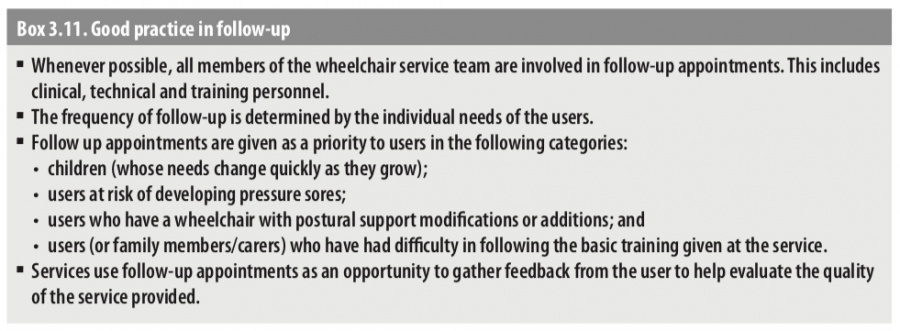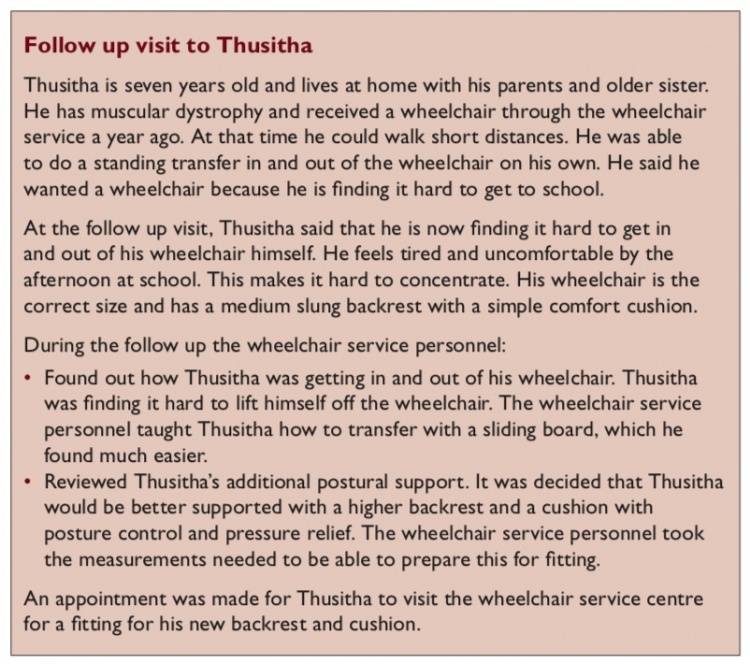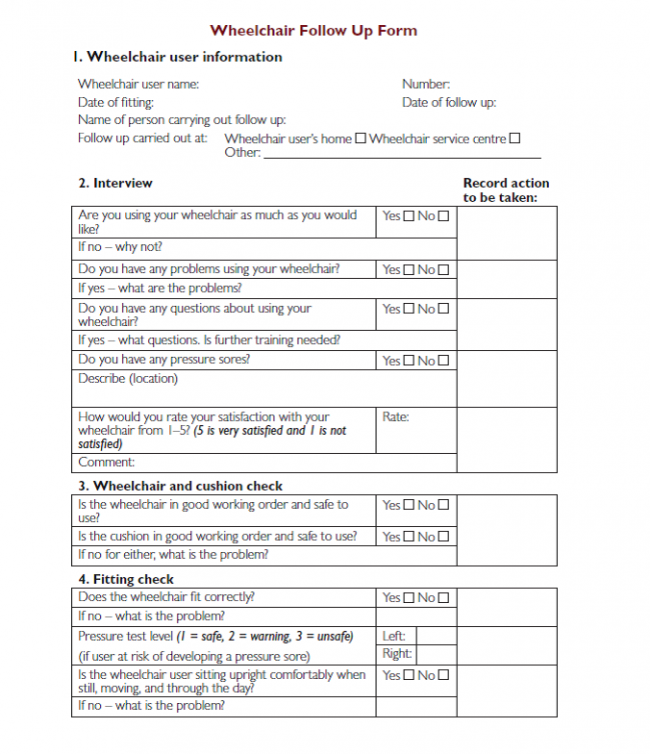Wheelchair Service Follow Up: Difference between revisions
No edit summary |
m (Changed protection level for "Wheelchair Service Follow Up": Course Page ([Edit=⧼protect-level-ppadmin⧽] (indefinite) [Move=⧼protect-level-ppadmin⧽] (indefinite))) |
||
| (10 intermediate revisions by 4 users not shown) | |||
| Line 1: | Line 1: | ||
<div class="editorbox"> | <div class="editorbox"> | ||
'''Original Editor '''- | '''Original Editor '''- [[User:Naomi O'Reilly|Naomi O'Reilly]] as part of the [[Wheelchair Service Provision Content Development Project]] | ||
'''Top Contributors''' - {{Special:Contributors/{{FULLPAGENAME}}}} | '''Top Contributors''' - {{Special:Contributors/{{FULLPAGENAME}}}} | ||
| Line 7: | Line 7: | ||
Follow up happens after the wheelchair user has received their wheelchair and has been using it for a while. Follow up appointments are an opportunity to; gather information from the wheelchair user, check that the wheelchair is in good working order and check the fitting of the wheelchair.<ref name=":0">Sarah Frost, Kylie Mines, Jamie Noon, Elsje Scheffler, and Rebecca Jackson Stoeckle. Wheelchair Service Training Package - Reference Manual for Participants - Basic Level. World Health Organization, Geneva. 2012</ref> | Follow up happens after the wheelchair user has received their wheelchair and has been using it for a while. Follow up appointments are an opportunity to; gather information from the wheelchair user, check that the wheelchair is in good working order and check the fitting of the wheelchair.<ref name=":0">Sarah Frost, Kylie Mines, Jamie Noon, Elsje Scheffler, and Rebecca Jackson Stoeckle. Wheelchair Service Training Package - Reference Manual for Participants - Basic Level. World Health Organization, Geneva. 2012</ref> | ||
All users will benefit from a follow up visit, particularly children, users at risk of developing a pressure sore, users who have a progressive condition and those who have had difficulty with any of the training or instruction given to them. | All users will benefit from a follow up visit, particularly children, users at risk of developing a pressure sore, users who have a progressive condition and those who have had difficulty with any of the training or instruction given to them. Most intermediate level wheelchair users need additional postural support, and therefore follow up is particularly important.<ref name=":0" /> | ||
Most intermediate level wheelchair users need additional postural support, and therefore follow up is particularly important. | |||
There is no rule about when follow up should happen though one follow up session within six weeks of the date of delivery is often found to be useful. it will depend on the needs of the user. However, for children, it is ideal if follow up occurs on a regular basis at least every three - six months, as their needs can change quickly as they grow.<ref name=":0" /><ref name=":1">Sarah Frost, Kylie Mines, Jamie Noon, Elsje Scheffler, and Rebecca Jackson Stoeckle. Wheelchair Service Training Package - Reference Manual for Participants - Intermediate Level. World Health Organization, Geneva. 2013</ref> | There is no rule about when follow up should happen though one follow up session within six weeks of the date of delivery is often found to be useful. it will depend on the needs of the user. However, for children, it is ideal if follow up occurs on a regular basis at least every three - six months, as their needs can change quickly as they grow.<ref name=":0" /><ref name=":1">Sarah Frost, Kylie Mines, Jamie Noon, Elsje Scheffler, and Rebecca Jackson Stoeckle. Wheelchair Service Training Package - Reference Manual for Participants - Intermediate Level. World Health Organization, Geneva. 2013</ref> | ||
| Line 17: | Line 15: | ||
Follow up can be carried out at a number of locations, depending on whether the wheelchair user is able to travel to the centre, and whether wheelchair service personnel are able to travel to the user’s home and can include; in the wheelchair user’s home, at the wheelchair service centre or at any other location that suits the wheelchair user and the wheelchair service personnel. <ref name=":0" /><ref name=":1" /> | Follow up can be carried out at a number of locations, depending on whether the wheelchair user is able to travel to the centre, and whether wheelchair service personnel are able to travel to the user’s home and can include; in the wheelchair user’s home, at the wheelchair service centre or at any other location that suits the wheelchair user and the wheelchair service personnel. <ref name=":0" /><ref name=":1" /> | ||
== Common Actions == | == Common Actions == | ||
'''Providing more Advice or Training;''' For example if a wheelchair user is not using their wheelchair as expected, it may be because they is not confident about how he/she can get in and out of the wheelchair when he/she is alone. More training in transfers can help to solve this problem. <ref name=":0" /><ref name=":1" /> | |||
'''Check the Wheelchair is in good working order and re-adjust the wheelchair;''' Carrying out minor repairs and always encourage wheelchair users and their family members/caregivers to maintain the wheelchair by carrying for a wheelchair at home. Wheelchair service personnel can also help the wheelchair user to arrange for major repairs if it is not possible to fix any broken parts immediately. <ref name=":0" /><ref name=":1" /> | |||
'''Referring the wheelchair user to another service for support or assistance.''' | |||
Referring the wheelchair user to another service for support or assistance. | |||
Personnel should make a note of any action that is needed after the follow up visit. | '''Personnel should make a note of any action that is needed after the follow up visit.''' | ||
== Management of Follow Up Appointments == | == Management of Follow Up Appointments == | ||
| Line 36: | Line 30: | ||
== Good Practise == | == Good Practise == | ||
[[File:Good Practise - Follow Up.jpeg | [[File:Good Practise - Follow Up.jpeg|thumb|900x900px|<ref>William Armstrong, Johan Borg, Marc Krizack, Alida Lindsley, Kylie Mines, Jon Pearlman, Kim Reisinger, Sarah Sheldon. Guidelines on the Provision of Manual Wheelchairs in Less Resourced Settings. World Health Organization; Geneva: 2008. </ref>|center]] | ||
== Case Study == | == Case Study == | ||
[[File:Follow-Up CaseStudy.jpeg | [[File:Follow-Up CaseStudy.jpeg|thumb|750x750px|<ref name=":1" />|center]] | ||
== Resources == | == Resources == | ||
[[File:Wheelchair followup form.png|thumb|754x754px|center]] | |||
[[File:Wheelchair followup form.png| | |||
== References == | == References == | ||
<references /> | <references /> | ||
[[Category:Wheelchair Service Provision]] | |||
[[Category:Occupational Health]] | |||
[[Category:Assistive Technology]] | |||
[[Category:Interventions]] | |||
[[Category:Wheelchair Service Provision Content Development Project]] | |||
[[Category:Course Pages]] | |||
Latest revision as of 19:59, 2 March 2022
Original Editor - Naomi O'Reilly as part of the Wheelchair Service Provision Content Development Project
Top Contributors - Naomi O'Reilly, Kim Jackson, Rucha Gadgil, Amrita Patro and Olajumoke Ogunleye
Introduction[edit | edit source]
Follow up happens after the wheelchair user has received their wheelchair and has been using it for a while. Follow up appointments are an opportunity to; gather information from the wheelchair user, check that the wheelchair is in good working order and check the fitting of the wheelchair.[1]
All users will benefit from a follow up visit, particularly children, users at risk of developing a pressure sore, users who have a progressive condition and those who have had difficulty with any of the training or instruction given to them. Most intermediate level wheelchair users need additional postural support, and therefore follow up is particularly important.[1]
There is no rule about when follow up should happen though one follow up session within six weeks of the date of delivery is often found to be useful. it will depend on the needs of the user. However, for children, it is ideal if follow up occurs on a regular basis at least every three - six months, as their needs can change quickly as they grow.[1][2]
At the follow up the wheelchair service personnel should check that the wheelchair is in good order, provide more tips or training. If needed the service provider may re-adjust the wheelchair, carry out minor repairs or home maintenance, organize major repairs or assist the wheelchair user to arrange for repairs.
Follow up can be carried out at a number of locations, depending on whether the wheelchair user is able to travel to the centre, and whether wheelchair service personnel are able to travel to the user’s home and can include; in the wheelchair user’s home, at the wheelchair service centre or at any other location that suits the wheelchair user and the wheelchair service personnel. [1][2]
Common Actions[edit | edit source]
Providing more Advice or Training; For example if a wheelchair user is not using their wheelchair as expected, it may be because they is not confident about how he/she can get in and out of the wheelchair when he/she is alone. More training in transfers can help to solve this problem. [1][2]
Check the Wheelchair is in good working order and re-adjust the wheelchair; Carrying out minor repairs and always encourage wheelchair users and their family members/caregivers to maintain the wheelchair by carrying for a wheelchair at home. Wheelchair service personnel can also help the wheelchair user to arrange for major repairs if it is not possible to fix any broken parts immediately. [1][2]
Referring the wheelchair user to another service for support or assistance.
Personnel should make a note of any action that is needed after the follow up visit.
Management of Follow Up Appointments[edit | edit source]
- Give wheelchair users a follow up appointment when they receive their wheelchair.
- Visit wheelchair users at home for follow up, where possible.
- Ensure follow up visits are incorporated into routine visits to communities by Community-Based Rehabilitation (CBR) Personnel who have been trained to carry out wheelchair follow up.
- Arrange a follow up phone call if transport is difficult and the wheelchair user has access to a phone.
Good Practise[edit | edit source]
Case Study[edit | edit source]
Resources[edit | edit source]
References[edit | edit source]
- ↑ 1.0 1.1 1.2 1.3 1.4 1.5 Sarah Frost, Kylie Mines, Jamie Noon, Elsje Scheffler, and Rebecca Jackson Stoeckle. Wheelchair Service Training Package - Reference Manual for Participants - Basic Level. World Health Organization, Geneva. 2012
- ↑ 2.0 2.1 2.2 2.3 2.4 Sarah Frost, Kylie Mines, Jamie Noon, Elsje Scheffler, and Rebecca Jackson Stoeckle. Wheelchair Service Training Package - Reference Manual for Participants - Intermediate Level. World Health Organization, Geneva. 2013
- ↑ William Armstrong, Johan Borg, Marc Krizack, Alida Lindsley, Kylie Mines, Jon Pearlman, Kim Reisinger, Sarah Sheldon. Guidelines on the Provision of Manual Wheelchairs in Less Resourced Settings. World Health Organization; Geneva: 2008.









